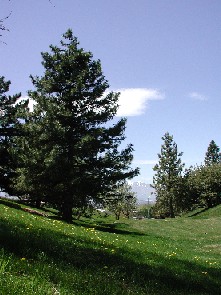
|
Vol.
12. No. 2
|
Fall
2002
|

Fort Douglas
Post Chapel
When
the University acquired another portion of Fort Douglas and began preparations
to house Olympic athletes there, I brought one of my mother's watercolor
paintings of the Fort Douglas Post Chapel to hang in my University office.
As a U student taking art classes in 1954, Dorothy Ann Moyle BA'56 depicted
the building from various angles in different seasons. It wasn't an assigned
subject; she just liked the look of the chapel. She returned to it with
her easel, brush, and paints on several occasions. The most prominent
features in my painting, in which one views the chapel from the rear,
are a trio of arched, lancet stained glass windows, the building's stone
foundation, and the large Celtic cross (since removed) atop the church's
steeple. As a youngster, I especially loved this painting with its green
landscape partially obscuring the chapel's north wall.
I became aware of the building itself when I attended a colleague's wedding there in the late 1980s. Like my mother, I was drawn to the chapel's form and history. I discovered that when approached from the chapel's entrance on old Fort Douglas Boulevard, the building's corner tower has a uniquely asymmetrical "witch's hat" roof supporting the steeple. According to one history of the building, this Gothic-Revival architectural design was common throughout the country as a style for churches but was rarely used on military posts such as Fort Douglas.
 How
the Post Chapel came to be constructed in a once-isolated place is a unique
story in its own right, provoking a consideration of the role of such
expressions of faith in the founding of this country. The Utah territory's
settlement came about after Brigham Young and his followers suffered a
long series of religious persecutions, culminating in their forced exodus
from Illinois. One cannot visit the state without becoming aware of the
necessity of sacred spaces to its inhabitants. This space, in particular,
has always been open to various faith communities.
How
the Post Chapel came to be constructed in a once-isolated place is a unique
story in its own right, provoking a consideration of the role of such
expressions of faith in the founding of this country. The Utah territory's
settlement came about after Brigham Young and his followers suffered a
long series of religious persecutions, culminating in their forced exodus
from Illinois. One cannot visit the state without becoming aware of the
necessity of sacred spaces to its inhabitants. This space, in particular,
has always been open to various faith communities.
The fort was established first to protect the Overland Mail Route from attack by hostile Indians. Col. Patrick E. Connor, appointed to lead this effort, also felt it was 23his duty to keep an eye on the Mormons, whose loyalty to the Union was suspect. Camp Douglas, later renamed Fort Douglas, was established in 1862 and named after the late Sen. Stephen A. Douglas of Illinois. The military outpost symbolizes the pervasive influ-ence of the federal government among the independent-minded inhabitants of the Mountain West's "Mormon Country."
The consolidation of military posts 20 years later resulted in the expansion of Fort Douglas to quarter 10 companies of infantry. Post Commander Col. Alexander McDowell McCook, a devout Presbyterian, ordered the soldiers to build a chapel to serve the enlarged encampment. It was completed in 1884 at a cost of $4,500. That same year, U.S. Secretary of War Robert T. Lincoln authorized the Second South Tramway Company to operate mule-powered cars to Fort Douglas' "Chapel Glen" ravine.
 Members
of the military and the Salt Lake City community continued to worship
in the Post until 1991. University historians claim that before the fort's
closure, the Post Chapel was the oldest continuously operational, multi-denominational
military chapel in the United States.
Members
of the military and the Salt Lake City community continued to worship
in the Post until 1991. University historians claim that before the fort's
closure, the Post Chapel was the oldest continuously operational, multi-denominational
military chapel in the United States.
The renovation of the Post Chapel was a substantial undertaking. When it became part of the University just over 10 years ago, it was in such bad shape that there was talk of tearing it down. Instead, members of the community pledged support to restore the chapel, which has housed weddings, funerals, public prayer services, and private devotionals over the years as the Interfaith House of Worship at the University of Utah. The restoration, completed this year, was made possible by the support of the Frederick Q. Lawson Foundation, the Janet Q. Lawson Foundation, the Episcopal Diocese of Utah, and contributions from many other individuals and faiths.
President Machen acknowledges
that it is rare for a public university to include an interfaith chapel
on its campus. But a complete education, he notes, is about "body,
mind, and spirit." ![]()
—Anne Palmer Peterson MPA'00 is former editor of Continuum.